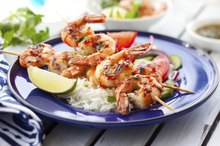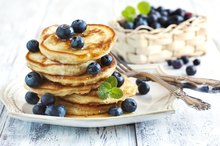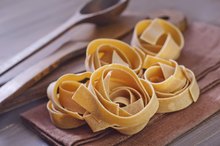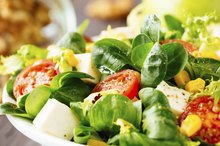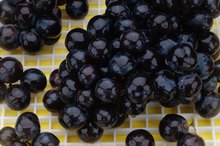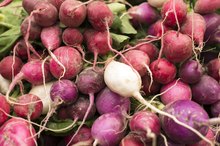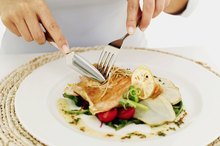What does fact checked mean?
At Healthfully, we strive to deliver objective content that is accurate and up-to-date. Our team periodically reviews articles in order to ensure content quality. The sources cited below consist of evidence from peer-reviewed journals, prominent medical organizations, academic associations, and government data.
The information contained on this site is for informational purposes only, and should not be used as a substitute for the advice of a professional health care provider. Please check with the appropriate physician regarding health questions and concerns. Although we strive to deliver accurate and up-to-date information, no guarantee to that effect is made.
List of Foods High in Uric Acid
Diet plays a significant role in managing gout -- a form of arthritis characterized by painful joints, commonly affecting the feet. Along with medication, lowering uric acid through diet is a primary tool in reducing gout attacks. Foods don't contain uric acid but instead supply substances called purines, which increase uric acid in the body. Having gout means you must limit foods high in purines to control uric acid levels.
Read more about uric acid foods to avoid.
Gout and the Role of Purines
Uric acid is a waste product found normally in your body as a result of purine digestion. Purine is a compound found mostly in animal protein. When you eat foods high in purines, you have higher uric acid levels. Gout occurs when uric acid accumulates in your body. It tends to run in families, with 20 percent to 80 percent of people having a family history of gout, according to MedlinePlus, and men experience the condition more than women or children 1. Other risk factors include being overweight, drinking too much alcohol and taking certain medications.
- Uric acid is a waste product found normally in your body as a result of purine digestion.
High-Purine Foods
Gout and Shrimp
Learn More
The typical diet contains 600 to 1,000 milligrams of purines daily, according to the Kidney Stone Treatment and Prevention Centers. Your doctor will likely recommend a low-purine diet to reduce your uric acid levels, which typically restricts you to 100 to 150 milligrams of purines daily. You must avoid organ meats since they're very high in purines. These foods contain anywhere from 234 to 554 milligrams of purines per serving.
- The typical diet contains 600 to 1,000 milligrams of purines daily, according to the Kidney Stone Treatment and Prevention Centers.
- Your doctor will likely recommend a low-purine diet to reduce your uric acid levels, which typically restricts you to 100 to 150 milligrams of purines daily.
Moderately High-Purine Foods
Some foods are moderately high in purines, characterized by a content of about 100 to 200 milligrams of purines per 100-gram serving. These foods include:
- cod
- beef sirloin
- lobster
- duck
- clam
- squid
- goose
- chicken breast
- bone-in pork chops
- salmon
Whole grains, beans and peas, sunflower seeds and some veggies -- such as spinach, asparagus and cauliflower -- also contain moderate amounts of purines. Ask your doctor whether you need to avoid these foods altogether or if you can have them in limited quantities.
General Dietary Guidelines
Buttermilk & Gout
Learn More
Follow the guidelines your dietitian or doctor gives you. General guidelines include avoiding alcohol because it can cause gout flareups, limiting red meat and poultry and increasing your intake of fruits and vegetables. Get at least 50 percent of your calories from carbohydrates and drink low-purine beverages like tea, coffee and fruit juices, recommends Myrtle Medical Center 3. In addition to these beverages, water also dilutes uric acid concentration, so drink plenty of it throughout the day.
Read more for a list of foods that reduce uric acid.
- Follow the guidelines your dietitian or doctor gives you.
- General guidelines include avoiding alcohol because it can cause gout flareups, limiting red meat and poultry and increasing your intake of fruits and vegetables.
Related Articles
References
- MedlinePlus: What Causes Gout
- North East Medical Services: Low Purine Diet
- Myrtle Medical Center: Low-Purine Diet
- The Merck Manual for Health Care Professionals. "Gout." Accessed March 25, 2016. http://www.merckmanuals.com/professional/musculoskeletal_and_connective_tissue_disorders/crystal-induced_arthritides/gout.html
- National Institute of Arthritis and Musculoskeletal and Skin Diseases. "Questions and Answers About Gout." Accessed March 25, 2016. http://www.niams.nih.gov/Health_Info/Gout
- The Merck Manual for Health Care Professionals. "Gout." Accessed March 25, 2016.
- National Institute of Arthritis and Musculoskeletal and Skin Diseases. "Questions and Answers About Gout." Accessed March 25, 2016.
Writer Bio
Janet Renee is a clinical dietitian with a special interest in weight management, sports dietetics, medical nutrition therapy and diet trends. She earned her Master of Science in nutrition from the University of Chicago and has contributed to health and wellness magazines, including Prevention, Self, Shape and Cooking Light.
